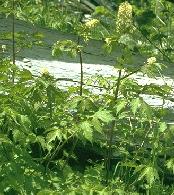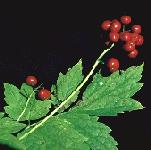

Red Baneberry
Actaca rubra Nutt.
A deciduous, bushy shaped perennial herd with an erect, branched stem 1 to 3 feet tall., with a large
basal leaf. Leaflets are 1-3 inches long, thin, ovate , and sharply incised and
toothed. White flowers with small white petals, showy stamens, and a rose like
fragrance, in a fluffy cluster. The fruit, a red berry, is
more conspicuous than the flower. The berry is mildly poisonous, acting upon the
heart. A greedy plant, inhibiting the growth of nearby plants, especially
legumes. It flowers from May and June to the first part of July and the fruit may
remain from mid August to October. It is found in moist or wet places, often in
shaded areas, along streams, about springs and boggy areas. It occurs from
valleys to about 9,000 feet in the mountains.
Caution: Baneberry is poisonous if eaten. The berries
are extremely bitter, but if eaten 2-4 berries can cause severe cramps,
vomiting, headaches, diarrhea, or dizziness.
Uses
Medicine: The whole plant, but especially the root, is analgesic,
ant rheumatic. The plant was often used
medicinally by North American Indian tribes, though modern users should be aware
of the plants potential toxicity. A tea made from the root is used as an
appetizer, in the treatment of stomach pains, coughs, colds, menstrual
irregularities, post partum pains, to increase milk flow and as a purgative
after childbirth.
